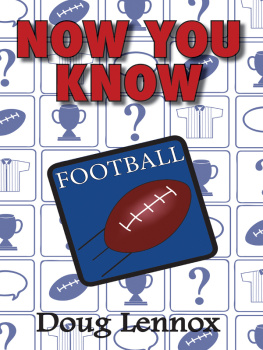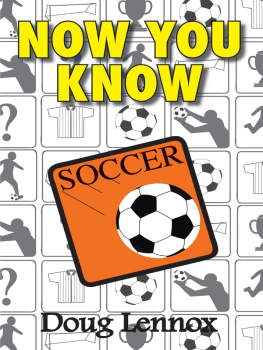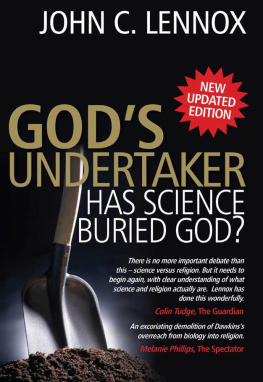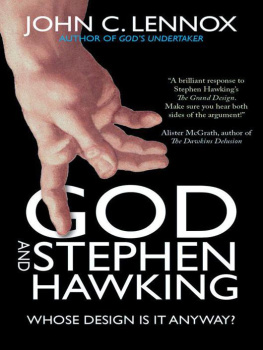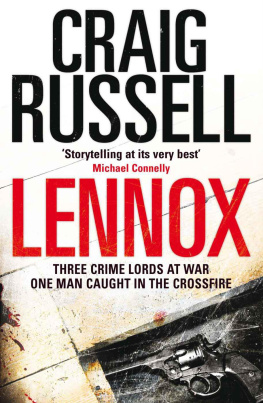Doug Lennox - Now You Know Big Book of Answers
Here you can read online Doug Lennox - Now You Know Big Book of Answers full text of the book (entire story) in english for free. Download pdf and epub, get meaning, cover and reviews about this ebook. publisher: Dundurn, genre: Detective and thriller. Description of the work, (preface) as well as reviews are available. Best literature library LitArk.com created for fans of good reading and offers a wide selection of genres:
Romance novel
Science fiction
Adventure
Detective
Science
History
Home and family
Prose
Art
Politics
Computer
Non-fiction
Religion
Business
Children
Humor
Choose a favorite category and find really read worthwhile books. Enjoy immersion in the world of imagination, feel the emotions of the characters or learn something new for yourself, make an fascinating discovery.

- Book:Now You Know Big Book of Answers
- Author:
- Publisher:Dundurn
- Genre:
- Rating:3 / 5
- Favourites:Add to favourites
- Your mark:
- 60
- 1
- 2
- 3
- 4
- 5
Now You Know Big Book of Answers: summary, description and annotation
We offer to read an annotation, description, summary or preface (depends on what the author of the book "Now You Know Big Book of Answers" wrote himself). If you haven't found the necessary information about the book — write in the comments, we will try to find it.
Now You Know Big Book of Answers — read online for free the complete book (whole text) full work
Below is the text of the book, divided by pages. System saving the place of the last page read, allows you to conveniently read the book "Now You Know Big Book of Answers" online for free, without having to search again every time where you left off. Put a bookmark, and you can go to the page where you finished reading at any time.
Font size:
Interval:
Bookmark:
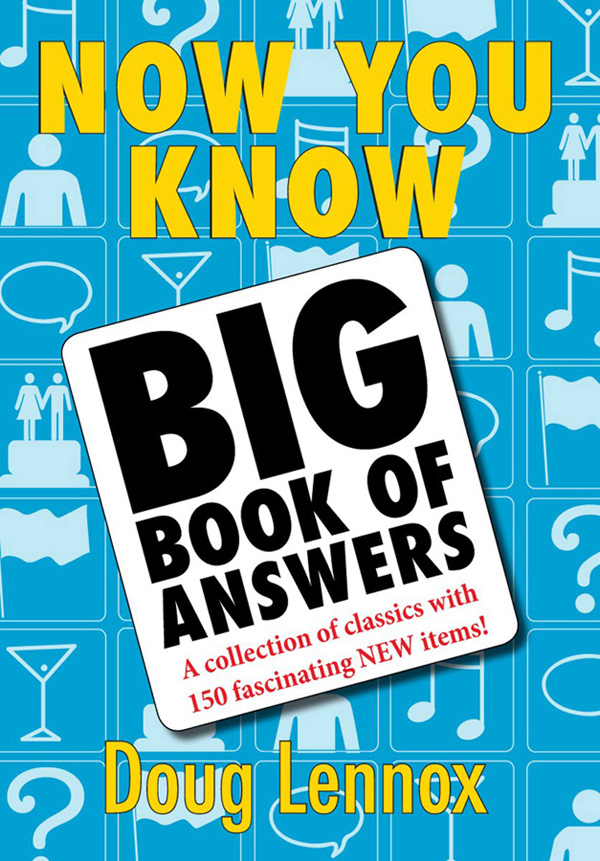
NOW YOU KNOW


Doug Lennox

Copyright Doug Lennox, 2007
All rights reserved. No part of this publication may be reproduced, stored in a retrieval system, or transmitted in any form or by any means, electronic, mechanical, photocopying, recording, or otherwise (except for brief passages for purposes of review) without the prior permission of Dundurn Press. Permission to photocopy should be requested from Access Copyright.
Editor: Andrea Waters
Design: Alison Carr
Printer: Trancontinental
Library and Archives Canada Cataloguing in Publication
Lennox, Doug
Now you know big book of answers / Doug Lennox.
ISBN 978-1-55002-741-9
1. Questions and answers. 2. Curiosities and wonders.
I. Title.
AG195.L45 2007 031.02 C2007-903004-1
1 2 3 4 5 11 10 09 08 07

We acknowledge the support of The Canada Council for the Arts and the Ontario Arts Council for our publishing program. We also acknowledge the Wnancial support of the Government of Canada through the Book Publishing Industry Development Program and The Association for the Export of Canadian Books, and the Government of Ontario through the Ontario Book Publishers Tax Credit program, and the Ontario Media Development Corporation.
Care has been taken to trace the ownership of copyright material used in this book. The author and the publisher welcome any information enabling them to rectify any references or credits in subsequent editions.
J. Kirk Howard, President
Printed and bound in Canada.
Printed on recycled paper.
www.dundurn.com
Illustrations on pages 15, 20, 29, 40, 46, 62, 73, 88, 102, 114, 140, 161, 162, 177, 187, 201, 203, 238, 251, 310, 318, 327, 349, 385, 389 by Catriona Wight.
Illustrations on pages 119, 278, 295, 308, 324 by Julia Bell.
Dundurn Press
3 Church Street, Suite 500
Toronto, Ontario, Canada
M5E 1M2
Gazelle Book Services Limited
White Cross Mills
High Town, Lancaster, England
LA1 4XS
Dundurn Press
2250 Military Road
Tonawanda, NY
U.S.A. 14150
This book is dedicated to my sister Marie
and the memory of Tony Derro.
Nothing worth possessing can ever be quite possessed.
D.L.
Some mentors can be younger than you.
My example is: Jean-Marie Heimrath.
My interest in why we say and do things comes from my fascination and research into human history as entertainment for earlier projects. My interest in statistics runs parallel with this, because the observation of both these subjects, as diverse as they are, always seems to initiate the same kind of surprise which must indicate that we are functioning without a clear understanding of what we are saying or doing. It was Mark Twain who said, There are lies, damn lies, and then there are statistics. The lies, however, are not within the statistics but rather within their application by those seeking to advance their own causes, and so it is with language.
We often hear expressions and words used in dramatic ways that, when examined closely, lose their logic. For example, some people say street smarts are an advantage in business, which is absurd. Street smarts (1972) means a basic cunning that is only useful on the street; to believe otherwise is delusional. Business smarts may have the same survivalist intent as street smarts, but they require far more sophistication.
All languages reveal the history of those who speak them, and none more so than English. As the global language, English is spoken as a first or second language by a third of the worlds population, approximately 1.9 billion people. Only Chinese and Hindi, through the sheer numbers of their populations, have more speakers. (If all the people in China began walking past a single point, the line would never end.)
During and after the Second World War, because they share the same language, the American and British governments took active measures to ensure that through conquest and occupation, their language would become the predominant means of communication on the planet. Their opponents were the Germans and the French. Spanish had diminished as a contender after Spain lost its empire. Today English is the official language of the United Nations and the European Union and by treaty is the international language for air traffic control and maritime communications. It is the principal language of the Internet, business, sports, and science. Knowing the proper use of the language is empowerment.
The English language is a fascinating conglomeration of words and expressions, from those begun by the invaders (Romans, Angles, Jutes, Saxons, Celts, and Vikings) who conquered and assimilated the native population of early Britain to the backwoods creations of North Americans (both enslaved and free) whose isolation and close proximity to the Native peoples gave the language a unique new richness. Other living everyday expressions and phrases were brought back from adventures, military and otherwise, from distant lands and the high seas to be assimilated into the English-speaking worlds common language.
For three hundred years after the 1066 conquest by William the Conqueror, French was the official language in Britain, with common English existing as a lower language of the people, and to this day French makes up 28.3 percent of the language we all speak and call English.
Although all entries in this book have been thoroughly researched, it is not an academic study. It is an entertaining and concise collection of the origins of our everyday language, customs, and rituals as well as some intriguing statistics and odds and ends to encourage a fun read. A way of passing time while picking up knowledge through what some might call trivia. It explores the DNA of our society and reveals how the things we say and do every day tie us to one rich heritage Enjoy!
Doug Lennox
www.douglennox.com

Why is a horseshoe thought to bring good luck?
A horseshoes charm comes from the legend of Saint Dunstan, who, because of his talent as a blacksmith, was asked by the Devil to shoe his cloven hoof. Saint Dunstan agreed, but in carrying out the task he caused the Devil such pain that he was able to make him promise never to enter a house that has a horseshoe hanging above the doorway. Thus, from the Middle Ages on, the horseshoe has been considered good luck.
Why does breaking a wishbone ensure good luck?
Twenty-four hundred years ago, because roosters heralded the sunrise and hens squawked before laying an egg, the Etruscans thought they were soothsayers. Because the sacred fowls collarbone resembled a human groin, it was believed to have special powers and was called a wishbone. The Romans introduced the custom of two people pulling on the wishbone to see whom luck favoured. The winner was said to have gotten a lucky break.
Font size:
Interval:
Bookmark:
Similar books «Now You Know Big Book of Answers»
Look at similar books to Now You Know Big Book of Answers. We have selected literature similar in name and meaning in the hope of providing readers with more options to find new, interesting, not yet read works.
Discussion, reviews of the book Now You Know Big Book of Answers and just readers' own opinions. Leave your comments, write what you think about the work, its meaning or the main characters. Specify what exactly you liked and what you didn't like, and why you think so.

